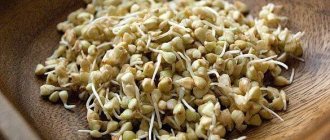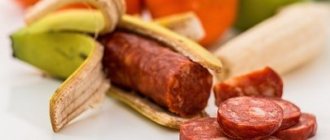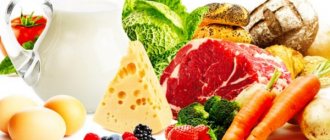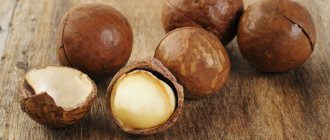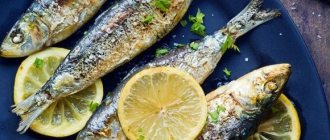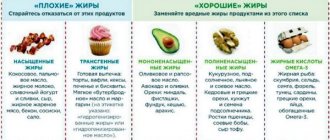Calorie content of canned fish. Chemical composition and nutritional value.
Nutritional value and chemical composition of “canned fish”.
| Nutrient | Quantity | Norm** | % of the norm in 100 g | % of the norm in 100 kcal | 100% normal |
| Calorie content | 88 kcal | 1684 kcal | 5.2% | 5.9% | 1914 |
| Squirrels | 17.5 g | 76 g | 23% | 26.1% | 434 g |
| Fats | 2 g | 56 g | 3.6% | 4.1% | 2800 g |
The energy value of canned fish is 88 kcal.
Primary Source: Created in the application by the user. Read more.
** This table shows the average levels of vitamins and minerals for an adult. If you want to know the norms taking into account your gender, age and other factors, then use the “My Healthy Diet” application.
Source
The history of canned fish
The history of the development of canned food begins in ancient times:
- The ancient Egyptians were the first to preserve food. They sealed clay vessels containing fried duck in olive oil with a special resin. Such canned food was discovered by archaeologists in the tomb of Tutankhamun. It is noteworthy that after lying for thousands of years, the product remained edible.
- For modern canned food, the world should thank the cook from Paris, Nicolas Francois Appert, who invented a method for long-term storage of food and founded the first canning factory.
- But the French were unable to hold their position; the British got down to business seriously. Instead of glass jars for packaging canned food, they used tin containers.
- Later, the Americans became interested in the technology and used tin cans for packaging.
- Pasteur scientifically substantiated the methods of canning.
Since then, the production methods have changed a lot, new technologies and opportunities have appeared. But the basis still remains the same.
Canned fish
Canned fish are fish products, processed, hermetically sealed, sterilized at a certain temperature fish products. The main feature of this product is its long-term storage.
Canned fish is made from natural raw materials and pre-prepared semi-finished fish products. Natural canned fish usually includes expensive fish species: salmon, sturgeon and salt. When making canned fish such as herring, mackerel, saury, halibut, a small amount of spices is also added.
Thus, natural canned fish is raw fish with added salt, heat-treated only during sterilization (calorizer). When producing canned food from semi-finished products, fish is pre-treated chemically (salt, spices, smoke, vegetable oil) or thermally. In addition, canned fish are distinguished by the type of filling. Canned food can be in oil, tomato, with vegetables or in “its own juice” (natural).
Calorie content of canned fish
The calorie content of canned fish is 88 kcal per 100 grams of product.
Composition and beneficial properties of canned fish
Of course, the nutritional value of canned fish is lower than, for example, boiled or baked fish, but it still retains a lot of useful substances.
They contain vitamins A, D, E, K, minerals: potassium, phosphorus, iron and others.
What to watch out for when eating canned fish
It should be remembered that in addition to beneficial properties, canned fish may also contain danger.
A disease such as botulism can be contracted by eating canned food. It is not the bacterium itself that is scary, but the toxins it produces. Therefore, it is recommended to sterilize canned food before use.
You should not consume a product that has expired if the can is swollen or deformed.
Also, you should not buy cheap canned food (calorizator). A low price may indicate that the manufacturer most likely saved on natural products by replacing them with chemical additives.
The use of canned fish in cooking
Canned fish is widely used in cooking. They are added to salads, appetizers, pies, and soups are cooked with them.
Source
Soup
This is one of the most popular and dietary dishes. To prepare, pour 1.5 liters of clean water into a saucepan and bring it to boil. While the water is heating, peel 1 carrot and 1 onion and cut them as you like. After the water in the pan boils, add the chopped vegetables and 2 tablespoons of rice. It takes 20 minutes to cook all this, then throw in the canned food that has been mashed with a fork and cook for another 10 minutes.
It is not necessary to add salt to this soup, since the canned food already contains some salt. But decorating the soup with fresh herbs before serving is very welcome. The dietary recipe does not contain potatoes, beans or other high-calorie components. But some women write in their reviews that they add these ingredients to make the soup more satisfying.
Soup is one of the popular dietary dishes
Summary table of calorie content and nutritional value of fish and seafood
Fish is an indispensable dietary product. It is tasty, healthy, contains fewer calories than meat, and is easier to digest. It contains many useful substances that are not found in meat. Thanks to this, fish has been used in dietetics for a long time, both for nursing sick people and for losing weight. Fish is part of many diets, for example: fish diet, south beach diet, fish and vegetable diet. Such famous diets as: the Dukan diet, the Kremlin diet, recommend fish as the main product that can replace meat.
How is fish useful?
Fish is rich in vitamins A and D and contains omega-3 fatty acids. Thanks to these substances, we get healthy skin, strong hair and nails, good vision, healthy blood vessels and heart, as well as energy for everyday life.
Application
This product is characterized by excellent taste. It is used in cooking for making soups, salads, snacks, and pies.
Harm of canned food: the greatest danger when consuming this is botulism - an infectious disease when infection occurs with toxins produced under a hermetically sealed lid. Unfortunately, it is difficult to determine by appearance whether canned food is hazardous to health. It is prohibited to eat canned food that has expired if the manufacturer is unknown and the shape of the packaging is somehow distorted.
Market Analytics
- 2020 in the beauty industry – innovation without borders
- Black Lives Matter movement: reaction and consequences for the beauty industry
- COVID-19 is changing the rules of the game in the cosmetics market
Convenient search for beauty salons on our website
Beauty salons in Moscow Beauty salons in St. Petersburg Beauty salons in Ekaterinburg Beauty salons in Novosibirsk
Latest blog posts on our website
- Naturecream / Tremella Extract - Snow Mushroom Detox for Skin
- Prostye-sovety / How to visually enlarge your lips with makeup
- Naturecream / Apricot kernel oil for face
- Naturecream / MATRIXYL3000 - the best skin elasticity stimulator
- Naturecream / SPF in Natural Oils
- Naturecream / Geranium (Pelargonium) oil for skin health and beauty
- Prostye-sovety / Save on a beauty salon: procedures that can be done at home
- Naturecream / Growth Factor - brings back youth?
- Oksana-Lezina / 3 effective abdominal exercises from a fitness instructor for beginners
- Prostye-sovety / Making perfect curls at home
Latest forum topics on our website
- Natalya / How to properly make a gelatin mask?
- Mrs._Smith / Badly sunburned! What to do?((
- Ice / Is it necessary to combine fitness classes with a diet?
- Antonova / What can be used for hair loss?
- Radio operatorKat / Who was on a protein diet?
Other articles in this section
| Pike in tomato sauce Pike is a predatory fish. She has a very large mouth containing many teeth. The teeth of this fish resemble hooks, and if the victim gets into the pike’s mouth, it will no longer be possible to escape from the mouth. |
| Nelma Nelma is a whitefish, belongs to the whitefish class, the salmon family. Nelma is a freshwater fish, semi-anadromous. Its habitat is the Arctic Ocean basin, the Manesi and Ponoi rivers. It is one of the largest representatives of its genus (weight can reach 50 kg, and dimensions up to 1.5 meters in length). |
| Pickled mussels Sea shellfish number more than 80 thousand species. Mussels, as representatives of this large species, are rightfully considered a delicacy. Their shells consist of two valves that regulate the flow of sea water - thanks to this, mussels contain a rich range of minerals and have a salty taste. |
| Fish milk Milk is the sperm of male fish. It is enclosed in a bag made of thin film. Their name comes from the milky color of the mature testes. The second name for milt is fish testes. |
| Boiled sturgeon Sturgeon is a large fish from the sturgeon family. The size of individual individuals reaches 300 kg. The fish has an elongated body and a head tapering towards the mouth. A distinctive feature of the sturgeon is the absence of scales. Instead, the fish has several bone plates located evenly along the entire length of the body - from head to tail. |
| Frozen fish sticks Fish sticks are the most successful product from the entire line of semi-finished fish products. Nourishing and light, easily digestible by the body, they will be an ideal snack. They look aesthetically pleasing and everyone loves them, so fish sticks will decorate any table. |
| Horse mackerel in oil Horse mackerel is a small sea fish belonging to the order Perciformes. Lives in warm waters near continents. The horse mackerel's body is oblong, slightly pressed laterally. The main difference is the bony scutes on the sides, located from the head to the tail. |
| Smoked trout Trout is a species of the salmon family. This fish lives in the North-West and Transcaucasia, it can be found in lakes. But in order to lay eggs, trout swim to rivers and streams that flow into the body of water in which the fish lives. But it happens that the fish does not swim away and spawns directly in the lake. Once the fry are released, they separate. Some go to live in rivers and streams, while others return to the lake. |
| Smoked salmon The main feature that distinguishes smoked salmon from any other is its divine aroma. The homeland of salmon is Norway, and the Norwegians also became pioneers in smoking this wonderful fish. Archaeological finds confirm that already at the beginning of the 8th century, it was the Norwegian conquerors who smoked fish. They discovered that smoked seafood tastes much better and also lasts much longer. In the modern world, smoking is done even at home, in the most ordinary kitchens of the most ordinary apartments - fortunately, modern technologies allow it. |
| Halibut Halibut is a fish of the northern and Far Eastern seas, belonging to the flounder family. It lives in the northern waters of the Atlantic and Pacific Oceans. Halibut has a unique appearance, which consists in the presence of two eyes in this fish, located one above the other on one side of the body. It is considered a deep-sea fish with a flat body. |
Calorie content of canned fish. Chemical composition and nutritional value.
Nutritional value and chemical composition of “Canned fish”.
| Nutrient | Quantity | Norm** | % of the norm in 100 g | % of the norm in 100 kcal | 100% normal |
| Calorie content | 192 kcal | 1684 kcal | 11.4% | 5.9% | 877 g |
| Squirrels | 13 g | 76 g | 17.1% | 8.9% | 585 g |
| Fats | 14 g | 56 g | 25% | 13% | 400 g |
| Carbohydrates | 3.5 g | 219 g | 1.6% | 0.8% | 6257 g |
The energy value of canned fish is 192 kcal.
Primary Source: Created in the application by the user. Read more.
** This table shows the average levels of vitamins and minerals for an adult. If you want to know the norms taking into account your gender, age and other factors, then use the “My Healthy Diet” application.
Source
Calorie content of canned fish
| Property | Meaning |
| Calorie content, kcal | 88 |
| Proteins, g | 17,5 |
| Fats, gr | 2 |
Canned fish in oil contains the following elements: Water, Sulfur, Chromium, Fluorine, Molybdenum, Nickel, Zinc, Chlorine.
| Micro and macro element | Meaning |
| Water, city | 70 |
| Sulfur, mg | 175 |
| Chromium, µg | 55 |
| Fluorine, mcg | 430 |
| Molybdenum, mcg | 4 |
| Nickel, µg | 6 |
| Zinc, mg | 0,7 |
| Chlorine, mg | 165 |
Canned fish in oil contains the following vitamins: Water, Sulfur, Chromium, Fluorine, Molybdenum, Nickel, Zinc, Chlorine.
| Vitamin | Meaning |
| Vitamin PP (Niacin equivalent), mg | 2,905 |
| Product | Kcal | Proteins, g | Fats, g | Angle, g |
| Baked or Fried Fish | 126 | 21,94 | 3,44 | 0,33 |
| Grilled fish | 109 | 22,6 | 1,18 | 0,28 |
| Crab sticks | 88 | 17,5 | 2 | 0 |
| Fish sprats | 136,8 | 17,1 | 7,6 | 0 |
| Canned sprats | 363 | 17,4 | 32,4 | 0 |
| Minced fish | 99 | 15,18 | 0,9 | 6,85 |
| Fish balyk | 194 | 20,4 | 12,5 | 0 |
| Semi-finished fish products | 209,2 | 12,5 | 6,7 | 14,7 |
| Frozen fish sticks | 206 | 9,47 | 8,65 | 22,34 |
| Canned fish | 88 | 17,5 | 2 | 0 |
| Dried fish | 88 | 17,5 | 2 | 0 |
| Marinated fish | 82 | 1,7 | 3 | 11,4 |
| Dried fish | 88 | 17,5 | 2 | 0 |
| Lamprey fish | 88 | 17,5 | 2 | 0 |
| Pickled lamprey | 88 | 17,5 | 2 | 2 |
| Sprat pate | 195 | 12 | 14 | 5,3 |
| Fish fillet | 90,57 | 15,17 | 3,5 | 0 |
| Fish burgers | 113 | 12 | 0,8 | 19 |
| Yukola | 88 | 17,5 | 2 | 0 |
| Fish steak | 155 | 12,8 | 6 | 12 |
| Smoked fish | 195,88 | 26,78 | 9,88 | 0 |
| Salty fish | 190,75 | 19,23 | 2 | 0 |
| Bester fish | 147 | 21 | 0,7 | 0 |
| Surimi | 99 | 15,18 | 0,9 | 6,85 |
| Fish straw | 231 | 46 | 3 | 5 |
| Fish roll | 139,3 | 11,8 | 7,53 | 9,74 |
| Fish stroganina | 172,6 | 34,3 | 3,9 | 0,5 |
| White fish, all types, smoked | 108 | 23,4 | 0,93 | |
| White fish, all types, cooked | 172 | 24,47 | 7,51 | |
| White fish, all types, raw | 134 | 19,09 | 5,86 | |
| Drawer, all types, cooked in the heat | 128 | 26,3 | 1,72 | |
| Drawer, all types, raw | 100 | 20,51 | 1,34 | |
| Stuffed fish in sweet sauce | 84 | 9,07 | 1,73 | 7,41 |
| Semi-finished fish products, frozen, heated | 249 | 11,04 | 13,25 | 21,18 |
| Spot cooked in the heat | 158 | 23,73 | 6,28 | |
| Spot, raw | 123 | 18,51 | 4,9 | |
| Fish food waste | 88 | 17,5 | 2 | |
| Hot smoked fish | 88 | 17,5 | 2 | |
| Skin, bones, fish scales | 88 | 17,5 | 2 | |
| Fish bones | 88 | 17,5 | 2 | |
| Lichnya | 88 | 17,5 | 2 | |
| Mavrolycus | 173 | 14 | 13 | |
| Notoscopelus crowderi | 219,5 | 15,5 | 17,5 | |
| Small fish (I category) | 88 | 17,5 | 2 | |
| Salted fish | 88 | 17,5 | 2 | |
| Cold-smoked Azov-Black Sea tripe | 88 | 17,5 | 2 | |
| Cold smoked fish | 88 | 17,5 | 2 | |
| Canned fish in oil | 88 | 17,5 | 2 | |
| Canned fish in tomato sauce | 88 | 17,5 | 2 | |
| Sprats in oil. Canned food | 363 | 17,4 | 32,4 |
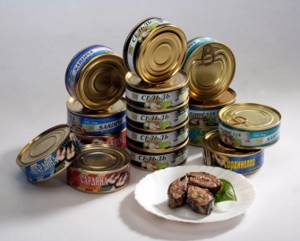
Depending on the type, all canned fish have different caloric content per 100 grams - from 88 to 350 Kcal. BJU ratio (approximate):
- 70 Kcal proteins;
- 18 kcal fat;
- there are no carbohydrates.
